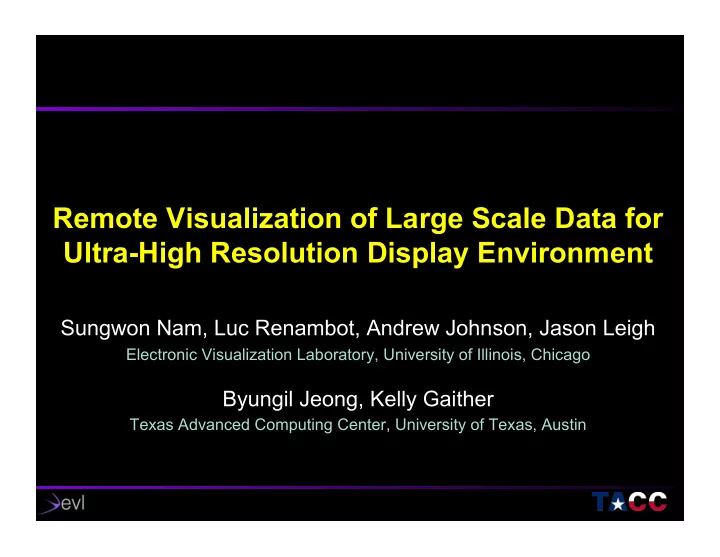

Remote Visualization of Large Scale Data for Ultra-High Resolution Display Environment Sungwon Nam, Luc Renambot, Andrew Johnson, Jason Leigh Electronic Visualization Laboratory, University of Illinois, Chicago Byungil Jeong, Kelly Gaither Texas Advanced Computing Center, University of Texas, Austin
Introduction • Explosive scientific data size increase – Very difficult to transfer the data – Exceed the capacity of modest visualization systems • Remote visualization using cyber-infrastructure – Depend on remote HPC resource for retrieving, handling and analyzing (visualization) data – Users see the result streamed over high-speed networks to their desktop computer Remote HPC resource image result visualization simulation storage users’ desktop
ParaView and SAGE • ParaView : one of the major scientific visualization tools – Well fit to the cyber-infrastructure model – Designed for large-scale parallel visualization – Rendering resolution is limited by remote client and network • SAGE : Scalable Adaptive Graphics Environment – Assuming ultra-speed network (at least gigabits per second) – High-resolution display helps scientific discovery – Enable remote visualization on ultra-resolution tiled display – Allow users to juxtapose multiple high-resolution visualizations • ParaView and SAGE integration – Enable remote visualization of multiple large-scale data-sets in ultra- resolution display environments
ParaView and SAGE Integration SAGE interface composite pixel steream parallel pixel ParaView servers simulation storage Paraview Servers streams ParaView Client < Scientific visualization pipeline using ParaView > SAGE driving < ParaView + SAGE > tiled display • ParaView servers visualize large-scale data in parallel • Resulting imagery generated on each server is composited and streamed as a single image to the client (ParaView only) • SAGE interface captures the pixel data from each server and streams in parallel (ParaView + SAGE)
Benefits of the Integration P araView servers parallel SAGE-enabled pixel collaboration streams endpoints SAGE SAGE driving Visualcasting tiled display servers P araView servers • Juxtapose multiple remote ultra-resolution visualizations • Distribute the visualizations to multiple tiled displays at collaboration endpoints
Related Work ParaView ParaView VisIt Chromium CGLX + SAGE Remote Yes Yes Yes - - visualization Local tiled display Yes Yes - Yes Yes support Multi-tasking Yes - - - - on tiled display High-res remote collaborative Yes - - - - visualization
Major Contributions • Provide users with a solution to visualize large-scale data at an ultra-high resolution using remote HPC resources • Open the potential to apply this approach to any VTK-based visualization application by integrating SAGE with VTK • Provide a guide for users about: – What would be the additional cost for high-resolution remote streaming in this solution? ( i.e. additional latency, performance overhead ) – What would be the minimum system requirement for this solution? ( i.e. required bandwidth, computing power, display resolution )
Video
SAGE Interface in VTK ParaView Server VTK RenderWindow parallel pixel SAIL streams • ParaView tiled-display mode - ParaView servers do sort-last rendering and compositing for each tile • Insert SAGE interface inside the VTK library which ParaView depends on.
SAGE Components LAN/ render capture synch split WAN capture sync splitting delay delay delay LAN/ into copy to synch display WAN buffer texture sync copy queueing delay delay delay S image • Render node C 1 + C 2 N ren _ node N ren _ node • Display node S image C 1 D Q + C 2 N rcv _ node + D Q N rcv _ node
Experimental Environment • Render nodes – TACC Spur vis nodes (16CPU cores, 4GPUs, and 128GB RAM per node). • Display nodes – EVL LambdaVision driven by Yorda cluster – Each node has AMD Opteron 2Ghz, 4GB RAM, – Nvidia Quardo graphics. – Each display node has two 1600x1200 LCD monitors • Network route – 10Gbps National Lambda Rail (Cavewave) via – San Diego
Frame Rate with Increasing Dataset Size
ParaView + SAGE Delay
Delay Incurred by SAGE
Future Work and Conclusion • Automatic generation of SAGE configuration • Integration with other parallel visualization applications • Remote ultra high-resolution visualization with ParaView integrated with SAGE – Visualize large dataset using parallel computation and rendering on remote servers – Stream high-resolution final image over high-speed network to the tiled-display in your lab • This will motivate more scientists to solve their problems using high-resolution displays and remote HPC resource
Acknowledgements • This project is supported by grants from the National Science Foundation. – NSF Award CNS-0420477, OCI-0441094, OCI-0225642, and OCI-0943559 • We would like to thank Alan Verlo, Lance Long (EVL/UIC), Greg Abram, Bill Jones, and Tommy Minyard (TACC/UT-Austin).
Thank you
Recommend
More recommend